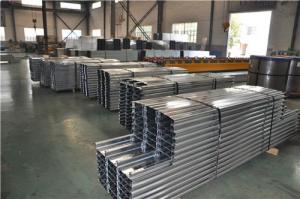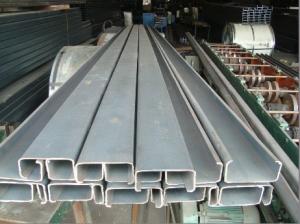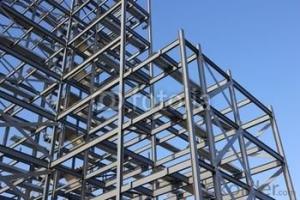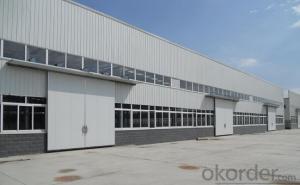C Channel Steel Bar
- Loading Port:
- China Main Port
- Payment Terms:
- TT or LC
- Min Order Qty:
- -
- Supply Capability:
- 30000 m.t./month
OKorder Service Pledge
OKorder Financial Service
You Might Also Like
Introduction
In architecture, structural engineering or building, a purlin (or historically purline, purloyne, purling, perling) is any longitudinal, horizontal, structural member in a roof except a type of framing with what is called a crown plate. In traditional timber framing there are three basic types of purlin: purlin plate, principal purlin and common purlin.
Description
1)Price:FOB $500-650
2)Material:Q195-Q420,Q195,Q215,Q235,Q345
3)Certification:ISO9001, SGS, BV
4)Payment term:TT,L/C
Specofications
1.Light,good strength,cauterization resistance and water resistance;
2.Matching magnesium fire-proof board,gypsum board,and many other wall and ceiling board;
3.Moisture -proof,shock-resistance,high-effecient,environmentally-friendly and so on;
4.Easy and fast for installation,time-saving;

- Q:What are the common materials used in steel structures?
- The common materials used in steel structures include structural steel, reinforcing steel, steel plates, and steel beams.
- Q:What are the design considerations for steel sports facilities?
- When designing steel sports facilities, it is important to take into account several important design considerations. These considerations include structural integrity, durability, flexibility, aesthetics, and sustainability. To begin with, ensuring the safety and stability of the facility is crucial, and this can be achieved by focusing on structural integrity. Steel is an ideal material choice for large-scale sports facilities due to its high strength-to-weight ratio. Factors such as wind and seismic loads, as well as the potential for heavy equipment and crowds, must be considered in the design process. Another key consideration is durability. Sports facilities are subject to constant use and exposure to various weather conditions, resulting in high levels of wear and tear. Steel is known for its resistance to corrosion, rust, and deterioration, making it a long-lasting solution for sports facilities. Implementing proper protective coatings and maintenance plans can enhance the durability of the steel structure. Flexibility is also important to accommodate different sports and events that may take place in the facility. Steel structures can be easily customized and modified without compromising their integrity. This allows for easy reconfiguration of spaces, addition of new features, or expansion of the facility to meet changing needs. The aesthetics of the sports facility play a significant role in attracting spectators and creating a visually appealing environment. Steel structures offer design flexibility, allowing architects to create unique and eye-catching sports facilities. Additionally, the use of steel can provide open and column-free spaces, enhancing sightlines and creating a better experience for spectators. Lastly, sustainability is an increasingly important consideration in sports facility design. Steel is highly sustainable as it is 100% recyclable and has a low carbon footprint. Incorporating steel in sports facility design can contribute to LEED certification and other sustainability goals. Furthermore, incorporating energy-efficient systems, such as natural lighting and HVAC systems, can further enhance the sustainability of the facility. In conclusion, when designing steel sports facilities, it is important to consider factors such as structural integrity, durability, flexibility, aesthetics, and sustainability. By carefully addressing these considerations, architects and engineers can create sports facilities that are safe, functional, visually appealing, and sustainable, meeting the demands of various sports and events.
- Q:How are steel structures designed for fireproofing?
- Steel structures are designed for fireproofing through various measures. One common approach is the application of fire-resistant coatings or paints on the steel surfaces, which provide a protective layer that delays heat transfer and prevents the steel from reaching critical temperatures. Additionally, steel structures may incorporate fire-resistant materials, such as intumescent coatings or fireproof insulation, to further enhance their fire resistance. Moreover, the design of steel structures takes into consideration factors like fire compartmentalization, adequate ventilation, and the inclusion of fire-resistant barriers to limit the spread of fire and smoke. These combined strategies ensure that steel structures maintain their structural integrity and protect occupants during a fire event.
- Q:What are the common applications of steel structures in residential buildings?
- Steel structures are commonly used in residential buildings for various applications such as beams and columns, roofing systems, and foundation supports. They provide a strong and durable framework that can withstand heavy loads, making them ideal for multi-storey buildings. Additionally, steel structures offer design flexibility, allowing for open floor plans and large, uninterrupted spaces. They are also resistant to fire, pests, and natural disasters, ensuring the safety and longevity of the residential building.
- Q:How do steel structures compare to concrete structures?
- The advantages and disadvantages of steel structures and concrete structures vary, and the decision on which to choose depends on factors such as cost, design requirements, and environmental considerations. In terms of strength, steel structures have a higher strength-to-weight ratio compared to concrete structures. This means that steel beams and columns can support larger loads with less material, resulting in structures that are lighter and more flexible. On the other hand, concrete structures are known for their durability and ability to withstand extreme weather conditions and natural disasters, making them suitable for buildings in earthquake or hurricane-prone areas. When it comes to construction time, steel structures often have the upper hand. Steel components can be prefabricated and easily assembled on-site, significantly reducing construction time. In contrast, concrete structures require more time for formwork, curing, and drying, which can prolong the construction process. Cost is another important factor to consider. While steel structures may have lower construction costs due to faster construction time and less material required, they often entail higher maintenance costs over time. Concrete structures, although initially more expensive to construct, have lower maintenance costs in the long run. Additionally, the price of steel is more volatile compared to concrete, making it less predictable in terms of cost. Aesthetics and design flexibility are also crucial considerations. Steel structures offer greater design flexibility, as steel beams and columns can be easily shaped and modified to create unique architectural features. Concrete structures, although less flexible in terms of shape, can be molded into various forms and textures, providing a wide range of design possibilities. Lastly, environmental considerations play a role in the decision between steel and concrete structures. Steel is highly recyclable and can be reused in other projects, making it a more sustainable option. On the other hand, concrete has a higher carbon footprint due to the production of cement, a key ingredient in concrete. To sum up, steel and concrete structures have their own strengths and weaknesses, and the choice between the two depends on factors such as cost, design requirements, construction time, and environmental considerations. Both materials have proven to be effective in creating durable and reliable structures, and the decision ultimately depends on the specific needs and priorities of the project.
- Q:How are the steel structures single, multi story and tall, super high-rise?
- Tall, super high-rise, mainly using steel mixed structure, such as cross column. Box shaped column and other structural forms.
- Q:How are steel structures used in the construction of cafes?
- Steel structures are commonly used in the construction of cafes due to their strength, durability, and flexibility. They provide a solid foundation and framework for the building, allowing for open and spacious interiors with large windows and open floor plans. Steel beams and columns can support heavy loads, making it possible to create multi-story cafes or incorporate mezzanine levels. Additionally, steel structures are resistant to fire, pests, and natural disasters, ensuring the safety of the cafe and its customers.
- Q:How are steel structures designed for different HVAC systems?
- Steel structures are designed for different HVAC systems by taking into consideration factors such as load requirements, space availability, and system specifications. Engineers and architects collaborate to ensure that the steel structure can support the weight and distribution of the HVAC equipment, while also allowing for proper airflow and ductwork installation. The design process involves analyzing the HVAC system's specific needs and integrating them seamlessly into the overall steel structure design to ensure optimal functionality and efficiency.
- Q:What are the cost considerations of using steel in structures?
- There are several cost considerations when using steel in structures. Firstly, the initial cost of steel itself is typically higher than other construction materials such as wood or concrete. Steel is a manufactured product that requires extensive processing and fabrication, which contributes to its higher price point. However, utilizing steel in structures can result in long-term cost savings. Steel is known for its durability and strength, which allows for the creation of lighter and more efficient structures. This can reduce the overall amount of material required for construction, leading to lower transportation and labor costs. Moreover, steel structures have a longer lifespan compared to other materials. Steel is resistant to decay, pests, and weathering, which means it requires less maintenance and repair over time. This can result in significant cost savings in terms of ongoing maintenance and replacement. Additionally, steel structures offer flexibility in design and construction, allowing for greater architectural freedom and creativity. The ability to prefabricate steel components off-site can speed up the construction process, saving both time and money. Lastly, steel structures are highly resilient to seismic activities and extreme weather conditions. This can result in lower insurance premiums and reduced risk of damage during natural disasters. In conclusion, while the initial cost of using steel in structures may be higher, the long-term cost considerations such as durability, efficiency, reduced maintenance, and flexibility make it a cost-effective choice in many construction projects.
- Q:How are steel structures used in mining and mineral processing plants?
- Steel structures are widely used in mining and mineral processing plants due to their strength, durability, and versatility. They provide support for heavy machinery and equipment, including crushers, conveyors, and processing units. Steel structures also house storage areas for minerals and facilitate efficient transportation within the plant. Additionally, steel is resistant to corrosion and can withstand harsh environmental conditions, making it suitable for the demanding requirements of mining and mineral processing operations.
1. Manufacturer Overview |
|
|---|---|
| Location | |
| Year Established | |
| Annual Output Value | |
| Main Markets | |
| Company Certifications | |
2. Manufacturer Certificates |
|
|---|---|
| a) Certification Name | |
| Range | |
| Reference | |
| Validity Period | |
3. Manufacturer Capability |
|
|---|---|
| a)Trade Capacity | |
| Nearest Port | |
| Export Percentage | |
| No.of Employees in Trade Department | |
| Language Spoken: | |
| b)Factory Information | |
| Factory Size: | |
| No. of Production Lines | |
| Contract Manufacturing | |
| Product Price Range | |
Send your message to us
C Channel Steel Bar
- Loading Port:
- China Main Port
- Payment Terms:
- TT or LC
- Min Order Qty:
- -
- Supply Capability:
- 30000 m.t./month
OKorder Service Pledge
OKorder Financial Service
Similar products
New products
Hot products
Related keywords




























